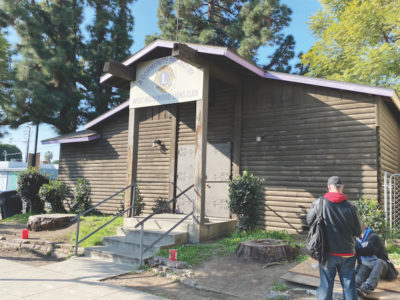On Preservation: Of log cabins and lost heritage in our communities

LOG CABIN is on a West Hollywood parcel owned by the City of Beverly Hills.
In early January, a controversy broke out between the cities of Beverly Hills and West Hollywood over the preservation of one of the unlikeliest monuments. In deciding to cash in on the flurry of development that is taking place up and down the small stretch of Robertson Blvd. in West Hollywood, between Santa Monica and Melrose, Beverly Hills announced it had decided to demolish the famed Log Cabin and clear the site (which Beverly Hill owns) for development.
The West Hollywood community was outraged. The humble Log Cabin on Robertson Blvd., which was originally built in 1928 or 1936 (sources vary) for Boy Scout Troop 27, was supposed to be demolished after the Scouts’ lease ended. That never happened, and the cabin was instead leased to the local Lion’s Club, which at some point decided to rent the space out for 12-Step recovery meetings, including Alcoholics Anonymous. It is through its prominent role as a refuge for recovery that the Log Cabin became, according to a new petition to save the landmark, “a much beloved and important community resource.” Such is the community support for the Log Cabin that West Hollywood Mayor John D’Amico and Councilman John Duran have both voiced their support for preservation.
“Abatement” demolition

COHANZAD family, of Wiseman Residential, used “abatement” to scar historic courtyard apartment building on Hawthorn Ave.
In nearby Hollywood, the clever gentlemen of Wiseman Residential would not make the same mistake as the city of Beverly Hills by announcing in advance their plans to demolish an historic building. Instead, they avoided public scrutiny by sending their minions at night to demolish 7054 and 7058 Hawthorn Ave. Designed by architect Gene Verge, designer of St. Luke’s Medical Center in Pasadena, the Jonathan Beach Club in Santa Monica, and the home of Buster Keaton, the 1941 courtyard apartment building was an identified historic resource in numerous surveys commissioned for the former Community Redevelopment Agency. Nonetheless, the building was partially demolished on Jan. 5 without permits, other than for “abatement.” What abatement meant in this case was the removal of all character-defining features and façade walls, making the building ineligible for landmark designation… de facto demolition.
A similar trick had been used in December by Philip Rahimzadeh to destroy a 1938 Paul Williams house under consideration for Historic Cultural Monument status at 100 Delfern Dr. in Brentwood. Wiseman Residential, aka the Cohanzad Family, has used all manner of chicanery in its business model. These developers are known to target historic, rent controlled, affordable apartment buildings. Their most egregious crimes have involved three historic properties, 423 N. Hayworth Ave., 419 N. Hayworth Ave., and 1332 Formosa Ave. They ran rings around Council District Five’s Paul Koretz, and in each case illegal activity was rewarded by a slap on the wrist and blamed on bureaucratic incompetence. As for Hawthorn, a campaign lead by Hollywood Heritage and concerned citizens is pressuring the city to take a stand. Perhaps Mitch O’Farrell running for re-election this year will ensure success where other attempts have failed.
Community esteem
What caught my interest about both these cases is that, yet again, historic structures, however shabby, quirky or run down, can be held in such esteem by the communities in which they reside. It’s that power of place and how it connects with memory, continuity, and identity that so draws the ire of the public when a structure is threatened.
Closer to home, the demolition of 361 S. Citrus Ave. by developer Reuven Gradon was such a case, as were the losses that led to the establishment of the Historic Preservation Overlay Zones of Windsor Square and Hancock Park. I recently went through last year’s agendas for the Greater Wilshire Neighborhood Council Land Use Committee, and I counted more than 45 planned demolitions of 100-year-old structures. While these old buildings, many humble bungalows dating from the 1910s, all are in areas long zoned “R3” for multi-family development and may not rise to the level of monument and will be little missed, they are still remnants of Los Angeles’ and our community’s history that are vanishing before our eyes. The real monuments deserve protection.
By Brian Curran
Category: Real Estate

Comments (1)
Trackback URL | Comments RSS Feed
Sites That Link to this Post